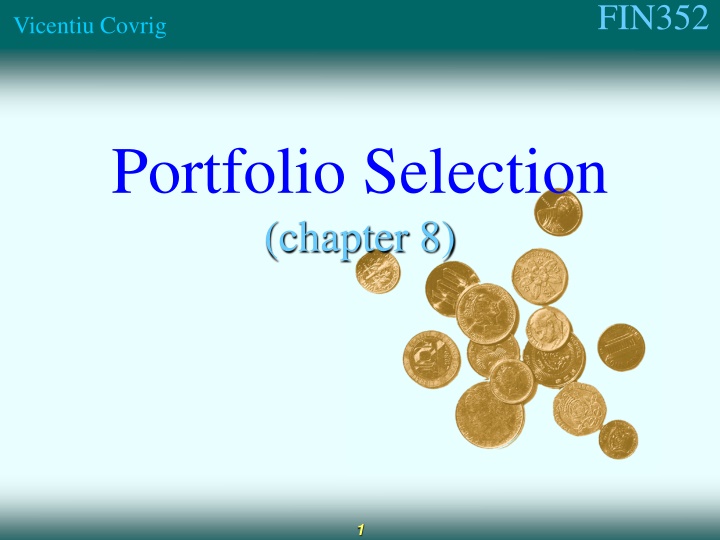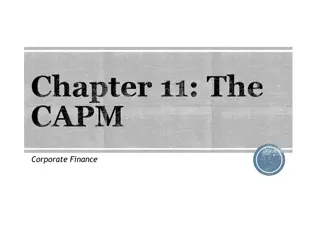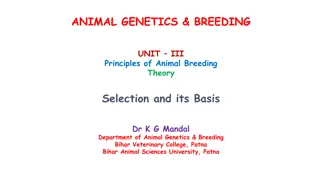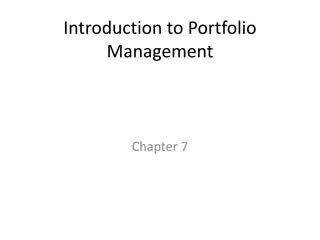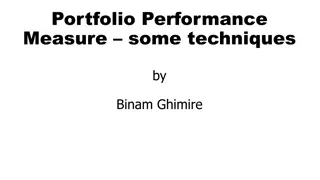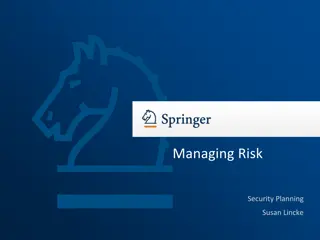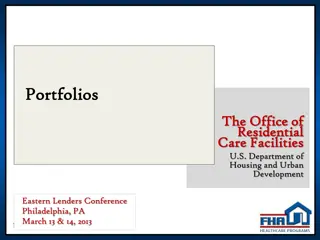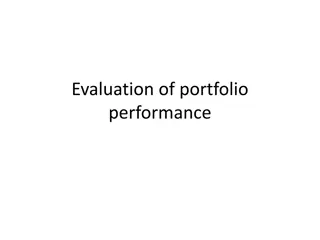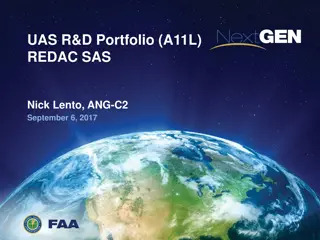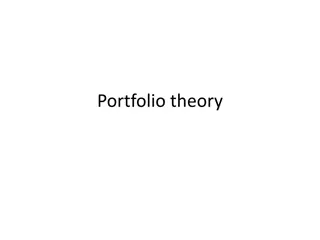Portfolio Selection and Risk Management
Explore the principles of portfolio selection and risk management in finance, emphasizing the importance of diversification and asset allocation. Learn how to identify optimal risk-return combinations, choose a portfolio based on preferences, and understand the concept of the efficient frontier. Discover how to select an optimal portfolio of risky assets using Markowitz analysis and indifference curves.
Download Presentation

Please find below an Image/Link to download the presentation.
The content on the website is provided AS IS for your information and personal use only. It may not be sold, licensed, or shared on other websites without obtaining consent from the author.If you encounter any issues during the download, it is possible that the publisher has removed the file from their server.
You are allowed to download the files provided on this website for personal or commercial use, subject to the condition that they are used lawfully. All files are the property of their respective owners.
The content on the website is provided AS IS for your information and personal use only. It may not be sold, licensed, or shared on other websites without obtaining consent from the author.
E N D
Presentation Transcript
FIN352 Vicentiu Covrig Portfolio Selection (chapter 8) 1
FIN352 Vicentiu Covrig 8-2 Building a Portfolio Diversification is key to risk management Asset allocation most important single decision Using Markowitz Principles - Step 1: Identify optimal risk-return combinations using the Markowitz analysis Inputs: Expected returns, variances, covariances - Step 2: Choose the final portfolio based on your preferences for return relative to risk 2
FIN352 Vicentiu Covrig Example: NOT on the EXAM % in stocks 0% 5% 10% 15% 20% 25% 30% 35% 40% 45% 50.00% 55% 60% 65% 70% 75% 80% 85% 90% 95% 100% Risk 8.2% 7.0% 5.9% 4.8% 3.7% 2.6% 1.4% 0.4% 0.9% 2.0% 3.08% 4.2% 5.3% 6.4% 7.6% 8.7% 9.8% 10.9% 12.1% 13.2% 14.3% Return 7.0% 7.2% 7.4% 7.6% 7.8% 8.0% 8.2% 8.4% 8.6% 8.8% 9.00% 9.2% 9.4% 9.6% 9.8% 10.0% 10.2% 10.4% 10.6% 10.8% 11.0% Portfolo Risk and Return Combinations Portfolio Return 12.0% 11.0% 100% stocks 10.0% 9.0% 8.0% 7.0% 100% bonds 6.0% 5.0% 0.0% 2.0% Portfolio Risk (standard deviation) 4.0% 6.0% 8.0% 10.0% 12.0% 14.0% 16.0% 3
FIN352 Vicentiu Covrig The Efficient Frontier Efficient Frontier represents the set of all mean/variance efficient (optimal) portfolios - Optimal portfolio has maximum return for a given level of risk or minimum risk for a given level of return - Portfolios on the efficient frontier dominate all other portfolios - No portfolio on the efficient frontier dominates another portfolio on the frontier 4
FIN352 Vicentiu Covrig Efficient Portfolios Efficient frontier or Efficient set (curved line from A to B) Global minimum variance portfolio (represented by point A) Portfolios on AB dominate those on AC B x E(R) A y C Risk = 5
FIN352 Vicentiu Covrig 8-6 Selecting an Optimal Portfolio of Risky Assets Portfolio weights are the output from Markowitz analysis Assume investors are risk averse Indifference curves (ICs) help select individual s optimal portfolio - IC, description of preferences for risk and return - IC reflects portfolio combinations that are equally desirable - ICs match investor preferences with portfolio possibilities 6
FIN352 Vicentiu Covrig The Optimal Portfolio Investor 2 indifference/utility curves Investor 1 indifference curves Efficient Frontier Goal is to achieve highest (most NW) attainable curve) 7
FIN352 Vicentiu Covrig 8-8 Selecting an Optimal Portfolio of Risky Assets Markowitz portfolio selection model - Assumes investors use only risk and return to decide - Generates a set of equally good portfolios - Does not address the issues of borrowed money or risk-free assets - Cumbersome to apply 8
FIN352 Vicentiu Covrig 8-9 Selecting Optimal Asset Classes Another way to use Markowitz model is with asset classes - Allocation of portfolio to asset types Asset class rather than individual security is most important for investors - Can be used when investing internationally - Different asset classes offer various returns and levels of risk Correlation coefficients may be quite low 9
FIN352 Vicentiu Covrig 8-10 Asset Allocation Includes two dimensions - Diversifying between asset classes - Diversifying within asset classes Asset classes include: - Equities foreign and domestic - Bonds - Treasury Inflation-Protected Securities (TIPS) - Alternative assets real estate, commodities, private equity, hedge funds, etc. 10
FIN352 Vicentiu Covrig Asset Allocation Correlation among asset classes must be considered Correlations change over time For investors, allocation depends on - Time horizon - Risk tolerance Diversified asset allocation does not guarantee against loss 11
FIN352 Vicentiu Covrig Asset Allocation Index Mutual Funds and ETFs - Cover various asset classes: domestic and foreign stocks (all investment styles), alternative assets (e.g. real estate, commodities), bonds of all types Life Cycle Analysis - Varies asset allocation based on investor age - Life-cycle funds (target-date funds) vary allocation as investor ages No one correct approach to allocation 12
FIN352 Vicentiu Covrig Systematic & Unsystematic Risk Total = Systematic + Unsystematic Risk Risk Risk p2 = Systematic + Unsystematic Variance Variance The variance (risk) of a portfolio, or a single security, consists of both systematic risk and unsystematic risk 13
FIN352 Vicentiu Covrig Systematic & Unsystematic Risk Systematic risk is not diversifiable - Systematic risk - risk of an overall movement in the market nondiversifiable systematic market Unsystematic risk is diversifiable - Unsystematic risk - risk of an event that is unique to the asset or a small group of assets diversifiable unsystematic unique 14
FIN352 Vicentiu Covrig Portfolio Risk and Diversification p % Total risk 35 Diversifiable (nonsystematic) risk 20 Nondiversifiable (systematic) risk 0 10 20 30 40 ...... 100+ Number of securities in portfolio 15
FIN352 Vicentiu Covrig Learning objectives Know the concept of optimal risk-return combinations Know the concepts of efficient frontier, global minimum variance, efficient set, indifference curves, and selecting optimal portfolio International diversification Important conclusions about Markowitz model Asset Allocation decision and major asset classes Asset allocation using stocks and bonds Systematic and nonsystematic risk End of chapter questions 8.1 to 8.7; 16
